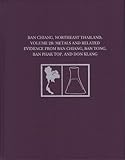Ban Chiang, Northeast Thailand, Volume 2B : Metals and Related Evidence from Ban Chiang, Ban Tong, Ban Phak Top, and Don Klang / ed. by Joyce C. White, Elizabeth G. Hamilton.
Material type: TextPublisher: Philadelphia : University of Pennsylvania Press, [2019]Copyright date: ©2019Description: 1 online resource (296 p.) : 22 color, 135 b/w illusContent type:
TextPublisher: Philadelphia : University of Pennsylvania Press, [2019]Copyright date: ©2019Description: 1 online resource (296 p.) : 22 color, 135 b/w illusContent type: - 9781931707923
- 959.3/021 23
- GN778.32.T5 B36 2018eb
- online - DeGruyter
| Item type | Current library | Call number | URL | Status | Notes | Barcode | |
|---|---|---|---|---|---|---|---|
 eBook
eBook
|
Biblioteca "Angelicum" Pont. Univ. S.Tommaso d'Aquino Nuvola online | online - DeGruyter (Browse shelf(Opens below)) | Online access | Not for loan (Accesso limitato) | Accesso per gli utenti autorizzati / Access for authorized users | (dgr)9781931707923 |
Frontmatter -- Contents -- List Of Figures -- List Of Tables -- Contributors -- 1. Introduction to the Analyses of Metals and Related Evidence from Ban Chiang, Ban Tong, Ban Phak Top, and Don Klang -- 2. Methods for Analysis of the Metal Artifacts -- 3. Classification of Metal Artifacts -- 4. Technical Analyses of Metal Artifacts: Results -- 5. Metal Product Manufacturing Evidence: Crucibles, Molds, and Slag -- 6. Depositional Contexts of Metals and Related Production Artifacts -- 7. Life History Perspectives on Metals and Related Finds -- Appendix A: Supplemental Data Tables -- Appendix B: Distribution Plans for Ban Chiang Non-burial Metal and Metal-related Artifacts by Site, Level, Square, and Quadrant -- Appendix C: Glossary -- References -- Index
restricted access online access with authorization star
http://purl.org/coar/access_right/c_16ec
The foundation of any archaeometallurgical study is study of excavated assemblages of metals and related remains. This volume presents in detail how the metals and such remains as crucibles excavated from four sites in northeast Thailand have been studied to understand the place of metal objects and technology in the ancient past of this region.In addition to typological examination, hundreds of technical analyses reveal the technological capabilities, preferences, and styles of metal artifact manufacturers in this part of Thailand. Detailed examination of contexts of recovery of metal remains employing a "life history" approach indicates that metal objects in those societies were used primarily in daily life and, only occasionally, as grave goods. The most surprising find is that casting of copper-base artifacts to final form took place at all these village sites during the metal age period, indicating a decentralized final production stage that may prove to be unusual for metal age societies. These insights are made possible by applying the methods and theories introduced in the first volume of the suite of volumes that study the metal remains from Ban Chiang in regional contest.Thai Archaeology Monograph Series, 2B; University Museum Monograph, 150
Mode of access: Internet via World Wide Web.
In English.
Description based on online resource; title from PDF title page (publisher's Web site, viewed 21. Jun 2021)


